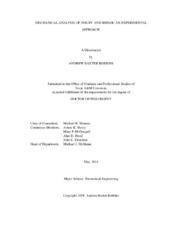| dc.contributor.advisor | Moreno, Michael R | |
| dc.creator | Robbins, Andrew Baxter | |
| dc.date.accessioned | 2019-01-17T19:15:41Z | |
| dc.date.available | 2020-05-01T06:25:27Z | |
| dc.date.created | 2018-05 | |
| dc.date.issued | 2018-04-27 | |
| dc.date.submitted | May 2018 | |
| dc.identifier.uri | https://hdl.handle.net/1969.1/173549 | |
| dc.description.abstract | The goal of the work described herein was to initiate development of new theoretical
and experimental tools specifically designed to improve bio-fidelity in the mechanical performance
of tissue-engineered constructs. Of particular interest was addressing present challenges
in producing tissue-engineered constructs that are biomimetic with respect to mechanical
behavior. Presently, there are no ASTM/ISO standards focused on the mechanical
characterization of tissue-engineered therapies. The absence of such a standard is important
exhibitory evidence of the need in this area. With this general understanding, the specific
effort described herein was motivated by the desire to develop the theoretical and technological
advances necessary to produce biomimetic tissue-engineered grafts for both off-the-shelf
and patient specific print-on-demand applications. Evidence acquired in conducting
this work suggests that the deficit in this area is vast and will ultimately require contributions
from many within the mechanics and tissue engineering communities.
As a first step, the work was focused on one-dimensional analysis of non-linear stress-strain
behavior with allowance for spatially varying properties along the one dimension.
Several conventional and well established non-linear models were compared. The approach
of Freed-Rajagopal was determined to be the most useful for tissue engineering applications
based on several factors. Employment of this model in a subsequent study was sufficient
to conclusively demonstrate that tissues described as biomimetic using conventional
approaches gleaned from the tissue engineering literature fail to mimic the mechanical behavior
of the native tissue when more appropriate non-linear models are used, e.g. the Freed-
Rajagopal 1-D Fiber model, to analyze the experimental data. Thus, considerable effort was
focused on the development of a more effective method and protocol for performing one-dimensional
tests on biologic tissues. The resulting protocol is presented in a format suitable
for development into an ASTM/ISO standard, i.e. as an ASTM/ISO proto-standard. Finally,
the ability to characterize the mechanical properties of a tissue using MRI elastography was
investigated with emphasis on the ability to map the spatial variation in mechanical properties.
The approach used here was based on an open source application. While the results
of that study revealed that there is potential to use MRI for this purpose, the open-source
algorithm was not sufficient for the intended application, and a more sophisticated method
will need to be developed. | en |
| dc.format.mimetype | application/pdf | |
| dc.language.iso | en | |
| dc.subject | mechanics | en |
| dc.subject | biomechanics | en |
| dc.subject | tissue engineering | en |
| dc.subject | biomimetic | en |
| dc.subject | standards | en |
| dc.subject | mechanical testing standards | en |
| dc.subject | hernia repair | en |
| dc.subject | collagen scaffolds | en |
| dc.subject | bTBI | en |
| dc.subject | blast injury | en |
| dc.subject | elastography | en |
| dc.title | Mechanical Analysis of Injury and Repair: An Experimental Approach | en |
| dc.type | Thesis | en |
| thesis.degree.department | Biomedical Engineering | en |
| thesis.degree.discipline | Biomedical Engineering | en |
| thesis.degree.grantor | Texas A & M University | en |
| thesis.degree.name | Doctor of Philosophy | en |
| thesis.degree.level | Doctoral | en |
| dc.contributor.committeeMember | Shetty, Ashok K | |
| dc.contributor.committeeMember | McDougall, Mary P | |
| dc.contributor.committeeMember | Criscione, John C | |
| dc.contributor.committeeMember | Freed, Alan D | |
| dc.type.material | text | en |
| dc.date.updated | 2019-01-17T19:15:41Z | |
| local.embargo.terms | 2020-05-01 | |
| local.etdauthor.orcid | 0000-0001-7663-2213 | |


